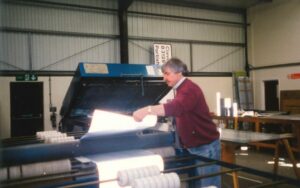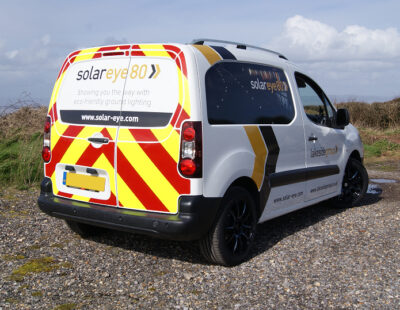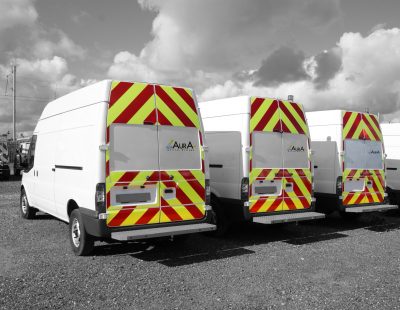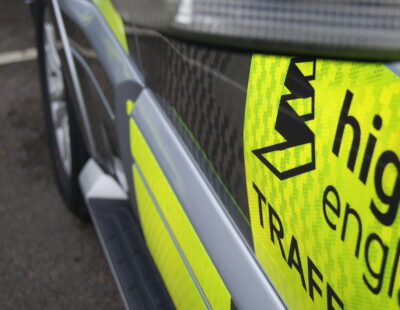Whilst night-time visibility is important, keeping your vehicle immediately visible to drivers during the day, particularly during low light levels such as dusk and dawn, is just as crucial. Without the appropriate markings, as per the Chapter 8 guidelines, you could be putting yourself or other drivers in danger.
Choosing the right fluorescent vinyl film is important for getting the best visibility for your vehicle. Here at Lakeside Group, we have put together a handy guide to help you understand the features and benefits of the two main types of vinyl film used for fluorescent chevron markings.
If you’d like to find out more about our services, feel free to get in touch. Otherwise, read on to find out more about the differences between cast and calendered fluorescent vinyl film.
The different types of fluorescent vinyl film
Choosing the right type of fluorescent vinyl for your vehicle is an important decision. Understanding what the types of vinyl film are, and the benefits of each, will help in making this decision.
There are two main types of fluorescent vinyl film used to mark vehicles and increase their visibility: cast, and calendered.
Find out more about fluorescent vinyl film with our beginners’ guide to chevron products >
How is fluorescent vinyl film made?
Vinyl, also known as PVC, comes in different forms that have properties determined by the specifics in their manufacturing process.
The basic process of making fluorescent vinyl film involves:
- Blending PVC resin with plasticisers and additives, such as colouring
- Forming the vinyl into film through a roll-to-roll process
- Applying an adhesive and release liner to the vinyl film
- Slitting and packaging rolls of the final product
The type of PVC resin used and the method through which the mix of materials is turned into film determines which type of vinyl film is produced.
What is fluorescent cast vinyl film?
Fluorescent cast vinyl film is made using a liquid mix of PVC resin, plasticisers, additives, and solvents which are coated onto a heat proof casting sheet, and then cured/dried in a special high-temperature oven. One of the biggest advantages of cast vinyl manufacturing is that vinyl film can be manufactured without a “memory”. This means that the film can typically be stretched without wanting to return to its original shape and that the cast vinyl films are more dimensionally stable.
The cast manufacturing process is also capable of producing extremely thin films, which can be ideal for many applications. In some instances, cast vinyl films can be manufactured at thicknesses below 25 microns. However, for applications requiring a film thickness greater than 250 microns, the liquid casting process often becomes cost-prohibitive.
Cast vinyl film is also typically more weatherable and can be used in outdoor environments for longer time frames without cracking or peeling which makes it ideally suited to the considerable demands of life on the roads.
To speak to us about your requirements for fluorescent vinyl film, get in touch today!
What is fluorescent calendered vinyl film?
Fluorescent calendered vinyl film is made using a solid powder mix of PVC resin, plasticisers and additives which are extruded and pressed through a series of large high-temperature polishing rollers which squeeze it down to the desired film thickness.
Calendered vinyl films can be manufactured at substantially greater thicknesses than cast vinyl film. Vinyl films with thicknesses greater than 400 or 500 microns can be cost-effectively manufactured through a calendaring process. This makes them ideal for applications such as roofing materials or heavy-gauge tarpaulins. The big down-side to calendered vinyl, however, is the dimensional stability. The process of heat-pressing the film through a series of polishing rollers tends to impart a “memory” into the film, which makes them less dimensional stable and will often lead to the film shrinking in the field.
The benefits of cast vs calendered vinyl film
While the manufacturing process is useful context for understanding why there’s a difference between the two types of vinyl film, understanding the benefits and drawbacks of each product type is essential in making the right decision for your vehicle.
Read our tips for using fluorescent vinyl films >
Dimensional stability
Because calendered vinyl film is made by squeezing the materials to make them thinner, they have a tendency over time to shrink as they return to their original shape. This “memory” means that calendered vinyl films are less dimensional stability than cast vinyl films.
Weatherability
Typically, cast vinyl films are more weatherable than calendered vinyl films, this is a significant consideration when it comes to choosing a fluorescent vinyl film for a Chapter 8 application because these types of vehicles tend to be constantly exposed to the elements.
How long will fluorescent vinyl film last?
While the longevity of the vinyl’s fluorescence may differ depending on the manufacturing method and the conditions it is exposed to, the fluorescent vinyl films we supply last between 12 months and 3 years.
Many fluorescent vinyl films available on the market fade completely to white in a relatively short time frame. In contrast, our premium 3-year fluorescent vinyl film (AURA® 139) fades to a non-fluorescent yellow colour. This means that the product is often used for longer as it still offers enhanced visibility, even after most of the fluorescence has faded.
AURA® 139 Flexicast™
Many of our customers will be familiar with AURA® 139 having benefited from its unrivalled durability and excellent fluorescence. After more than 10 years on the market, AURA® 139 has a solid reputation, and it’s just got even better!
In early 2024 we will be launching AURA® 139 Flexicast™ – a premium cast version of the original AURA® 139 fluorescent yellow-green vinyl adhesive film.
Like its predecessor, AURA® 139 Flexicast™ is designed for extended outdoor use and provides enhanced visibility to signs, graphics or vehicle markings, especially during lowlight hours. However, unlike the original AURA® 139, Flexicast™ is produced using a cast manufacturing process resulting in an extremely resilient product which is easy to handle and apply.
Unlike traditional cast graphic films, AURA® 139 Flexicast™ has a face film thickness near 150 microns, making it a uniquely thick cast film which is flexible, but not floppy and exceptionally strong.
Like its predecessor, AURA® 139 Flexicast™ will retain a non-fluorescent yellow colour after the fluorescent appearance fades. As such, the product can often be utilised for longer time frames as a non-fluorescent film even after most of the fluorescence has faded.
An increase in the longevity of your markings helps you stay visible on the roads for longer and reducers the rate at which you’ll need to make replacements – offering value for money.
Fluorescent vinyl films for road safety from Lakeside Group
Choosing the right fluorescent vinyl film for your vehicle will ensure it is visible on the roads, increasing your safety.
If you’re interested in what Lakeside Group can offer you, check out our products or get in touch! Keep on learning about what we do by reading a related article.
Find out more with our ultimate guide to vehicle livery and reflective vinyl for vehicles >
Check out our blog where we talk about micro-prismatic sheeting materials >




